Table of Contents
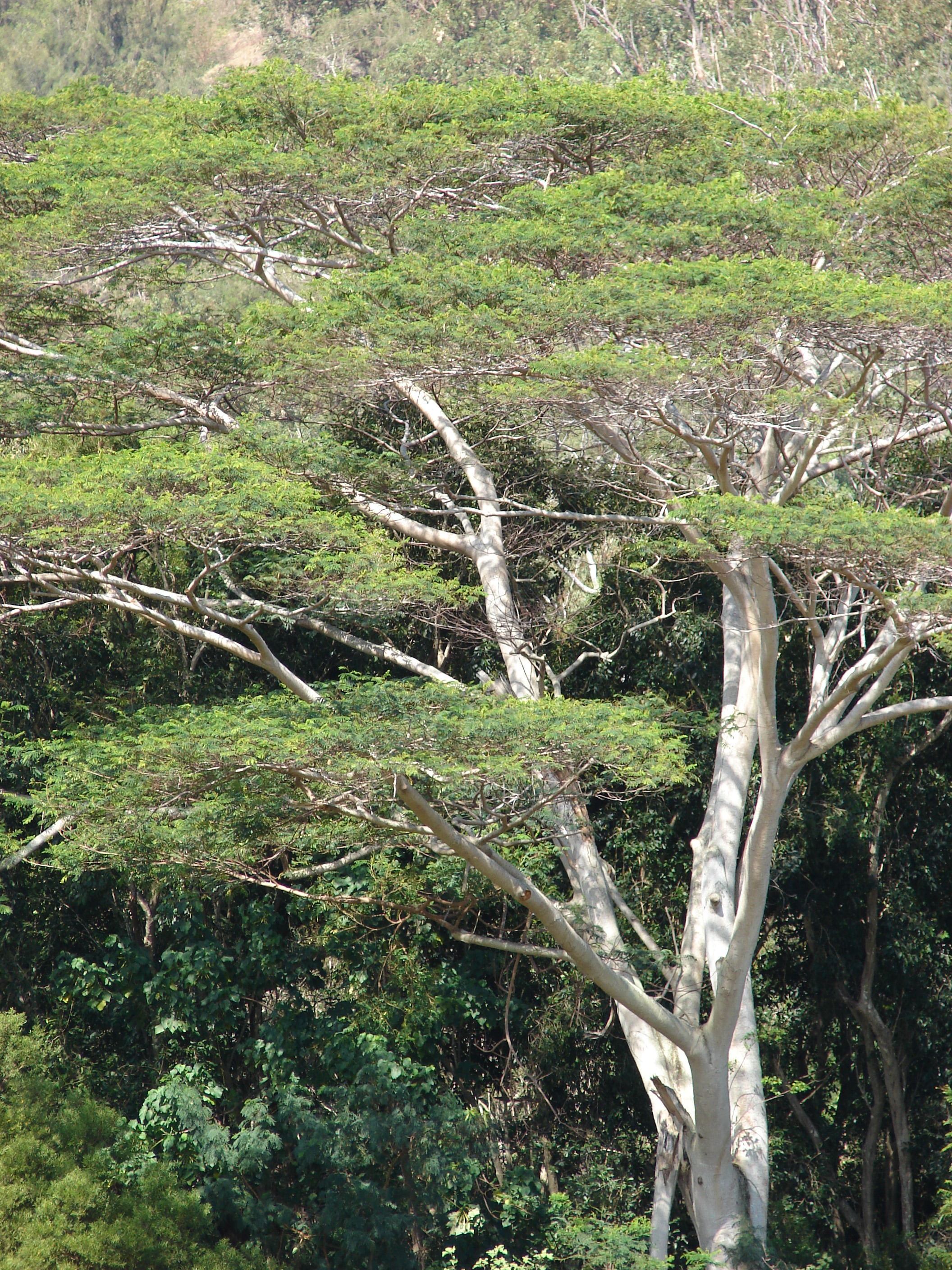 {1}
{1} Foreword:
Singapore has been known as the "Garden City" globally, however there are some cost to it, such as "bad trees" that poses a safety hazard when located near human activities. Hence, this pages aims to explore the "bad trees" Albizia in Singapore context and abroad. This page is written with the general public as the audience. In order for this page to be more informative for the general public and yet understandable, technical terms are provided with hyperlinks to external websites that provide more detailed explanation. Hopefully through this page, it also raises one's awareness of their safety, should any "bad Albizia tree" be found nearby. Apologies in advance should the hyperlinks expires.
Introduction:
- The Moluccan albizia tree, locally named in Singapore as "Albizia" tree, goes by the scientific name of Falcataria moluccana (formerly known as Paraserianthes falcataria). The scientific name for Albizia are often abbreviated into: F. moluccana and P. falcataria.
- Albizia is a flowering (angiosperm) eudicot and globally well known for its fast growth, nitrogen fixation abilities, multi-purpose wood, and potential to be invasive. The Albizia tree fast growth incurs a trade-off, in terms of earlier mortality than other trees(27). In layman terms, as the Albizia tree channels more resources to grow a tall trunk, it has less resources to make a thicker stronger trunk (softer wood) and has a shallow roots. Therefore, the Albizia tree has a higher chances being uprooted, blown over or broken by strong winds or loosen soil, compared to other trees. Hence, this poses a safety hazard for those in the vicinity.
Singapore Context:
- The Albizia tree was known to be introduced in the 1870s, and originally meant for providing shade or afforestation. However, it was gradually know to be invasive, and manged to spread its seeds across Singapore by wind. As this tree spreads naturally, tracking the status of this tree is currently deemed as "not practicable". These Albizia trees can be found on wasteland, small patches of vegetation around Singapore, and once found on vegetation along roadside.
Public Safety:
- The Albizia tree is considered as "storm vulnerable tree"(6) in Singapore, by Singapore Land Authority (SLA). Its shallow roots and soft wood, makes it prone to falling or branch breakage. Fallen Albizia tree along the roadside was known to have caused traffic jam. While there is approximately 70 cases of tree fall reported annually, these cases usually occurs on forested state land.
- However in May 2007, there was an unfortunate incident of a 10-storey tall Albzia tree in Bukit Batok Nature Park (secondary forest) which fell on three woman, resulting in one death and two casualties. Investigations has revealed that the healthy Albizia tree was likely uprooted because of the loosen soil by the rain, accompanied by strong winds. Hence, warning has been issued for the public to remain vigilant for sounds of collapsing tree when visiting vegetated nature sites around Singapore.
- Subsequent news regarding falling trees and branches, had also captured the media attention and was known to have induced "Falling Tree Anxiety" among some members of the public, as frequent tree inspections does not necessarily translate to zero risk.
Counter-measures Adopted By Singapore:
- Established in the 1960s, National Parks Board (NParks) is in charge of the inspections and maintenance of the trees and greenery across Singapore. The Tree Management Programme underwent several revision within the past few decades, noting that 62 people were injured and four people were killed by falling tree and branches to prevent reduce the frequency of further accidents. Examples of some counter-measures are mentioned below:
- Tree Inspection: Frequency of inspections for roads with high traffic, is increased to at least once very 12 months.
- Centre for Urban Greenery and Ecology (CUGE): This institute was set up in 2007 to train a workforce skilled in arboriculture (tree care), in collaboration with the International Society of Arboriculture (ISA).
- Tomograph: Similar to a fetus ultrasound, this device uses sound impulse to detect and monitor internal decay and cavity within the tree.
- Resistograph: This device drills into the wood to measure the wood density and detects internal defect in woods, to asses the risk of breakage.
- Removing Storm Vulnerable Trees: Trees such as Albizia along roadside are being removed and replaced by other species such as Tembusu, Sea Gutta and Jelutong.
- Crown reduction pruning: Tree crown is pruned to reduce the weight of tree crowns and surface area, upon encountering strong winds. However, pruning have not proven to be an effective measure to prevent the falling of Albizia tree.
- More information can be found in the website: NParks' Tree Management Programme
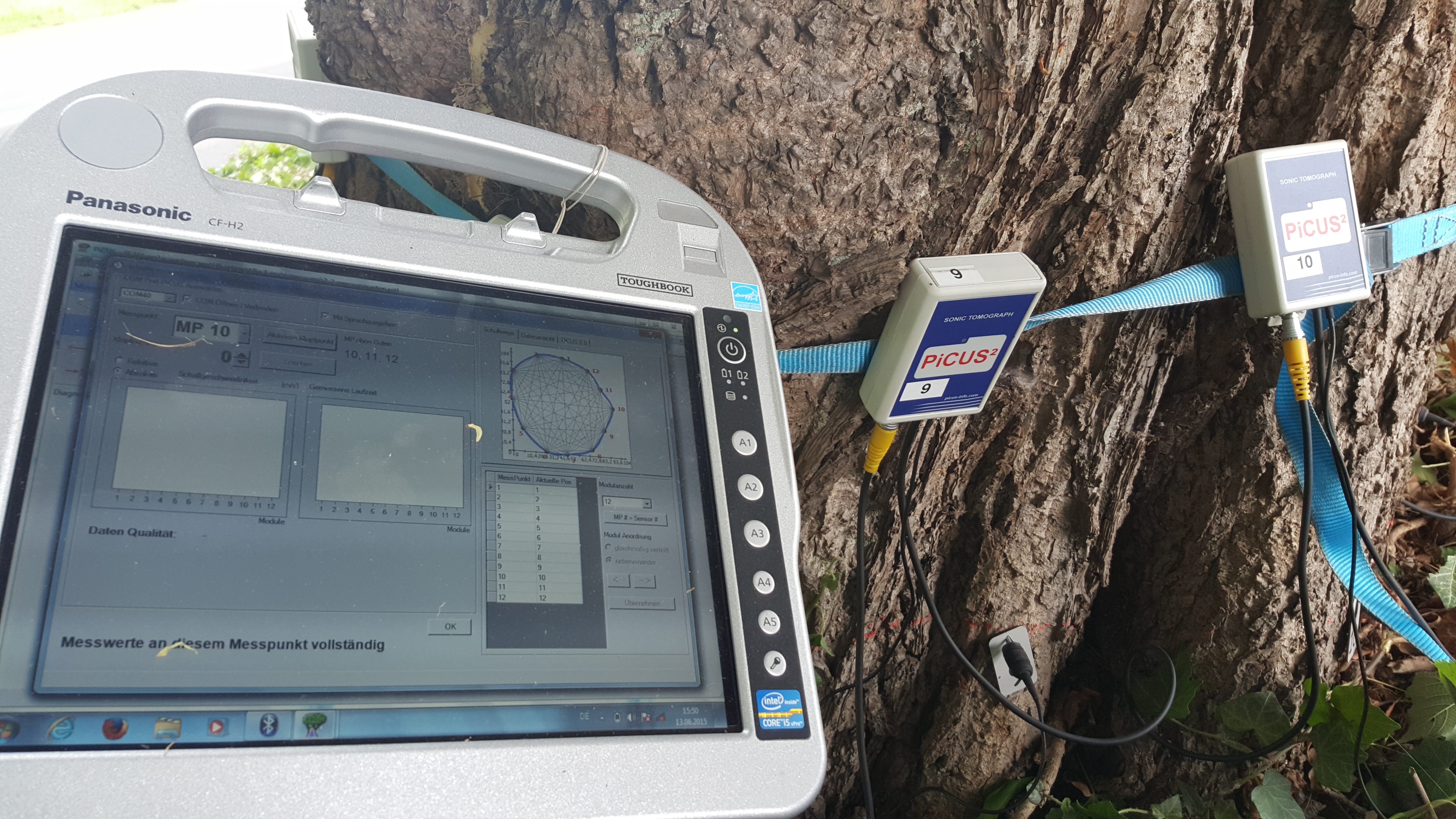 |
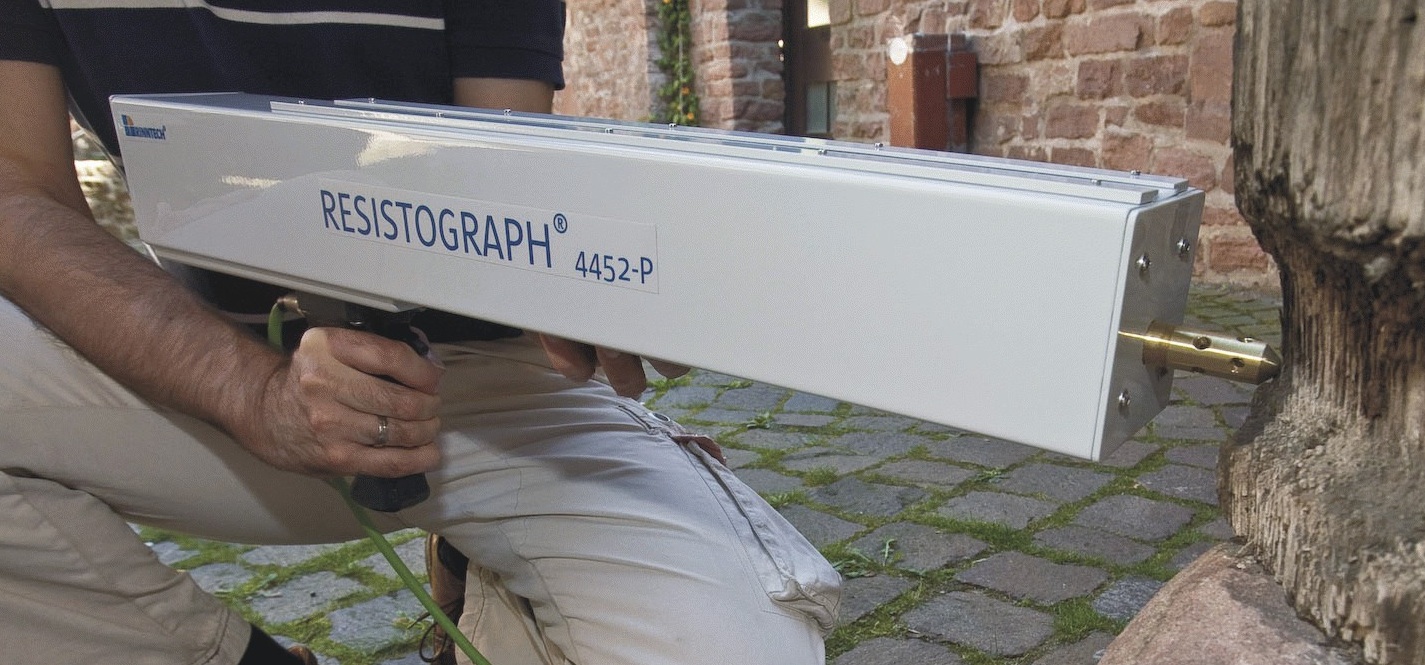 |
| Example of a Tomograph {2} |
Example of a Resistograph {3} |
Keeping Albizia?
- Despite the issues if public safety, some members of the public object to the removal of Albizia due to "nostalgic feelings" and the value of Albizia tree in the ecosystem. Hence, these trees which naturally growing in the wild, away from human activities, are left untouched. Ecological services provided by the Albizia tree, generally involves birds finding food and nesting materials, where competition for these resources were also noted by Bird Ecology Study Group (BESG) A few more commonly known birds seen utilizing the Albizia tree to nest are: Long-tailed Parakeet (Psittacula longicauda), White-bellied Sea Eagle (Haliaeetus leucogaster), and Common Flameback (Dinopium javanense). Interestingly, the natural cavities in these trees are also explored by the Great (Buceros bicronis) and Rhinoceros (Buceros rhinoceros) hornbills. Therefore, it is essential to remember that although these Albizia trees do indeed pose a safety hazard for humans, it still does have its value to exist in the wild and should not be blindly removed.
- It is a popular belief that there is no insurance cover for vehicle damaged by falling trees and branches as it falls under "Acts of God". However, certain motor insurance policies do cover for these damages.
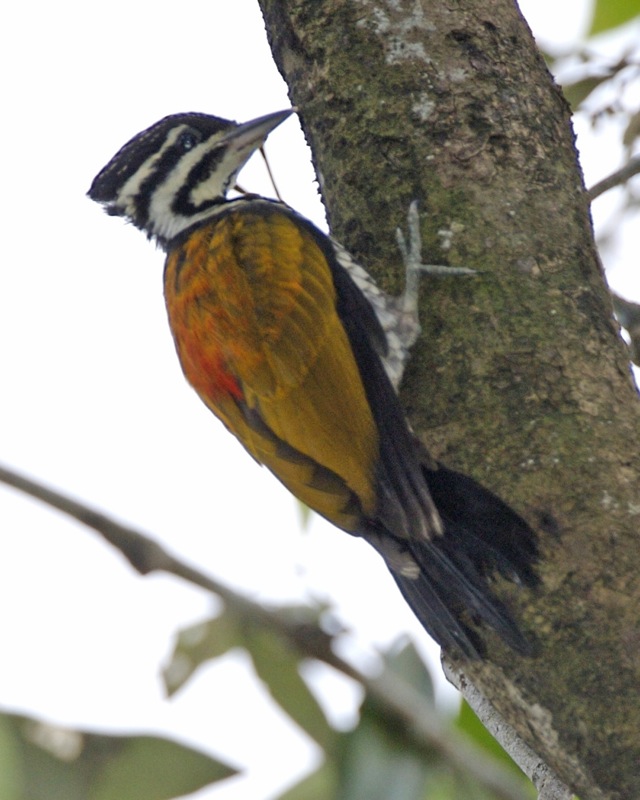 |
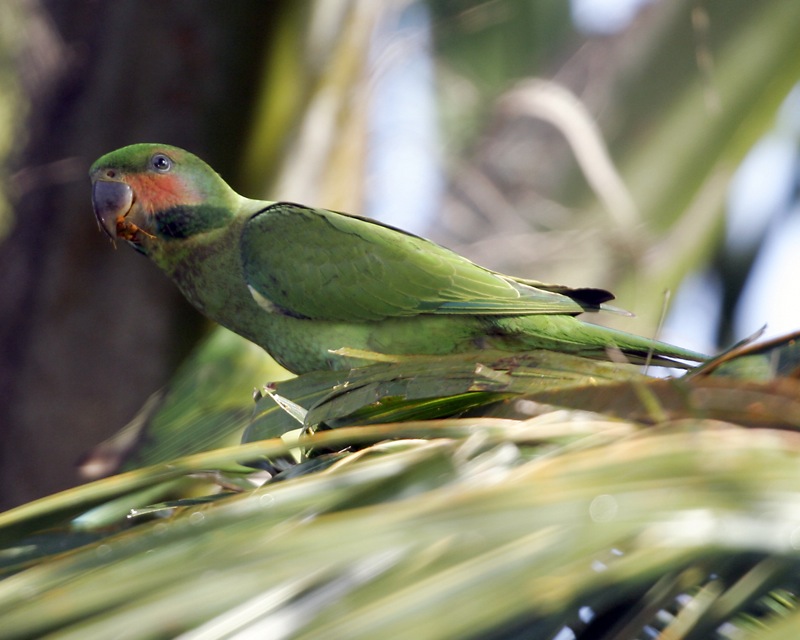 |
| Common Flameback {4} |
Long-tailed Parakeet {5} |
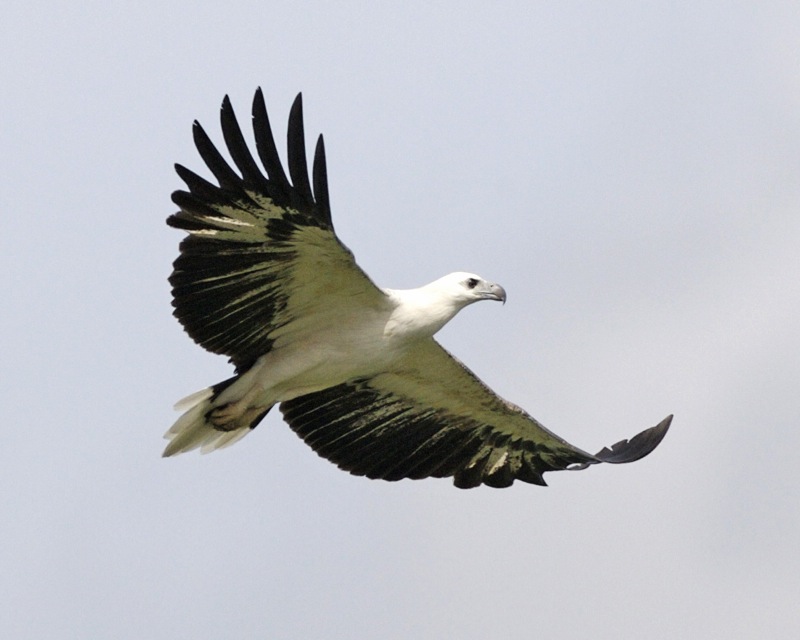 |
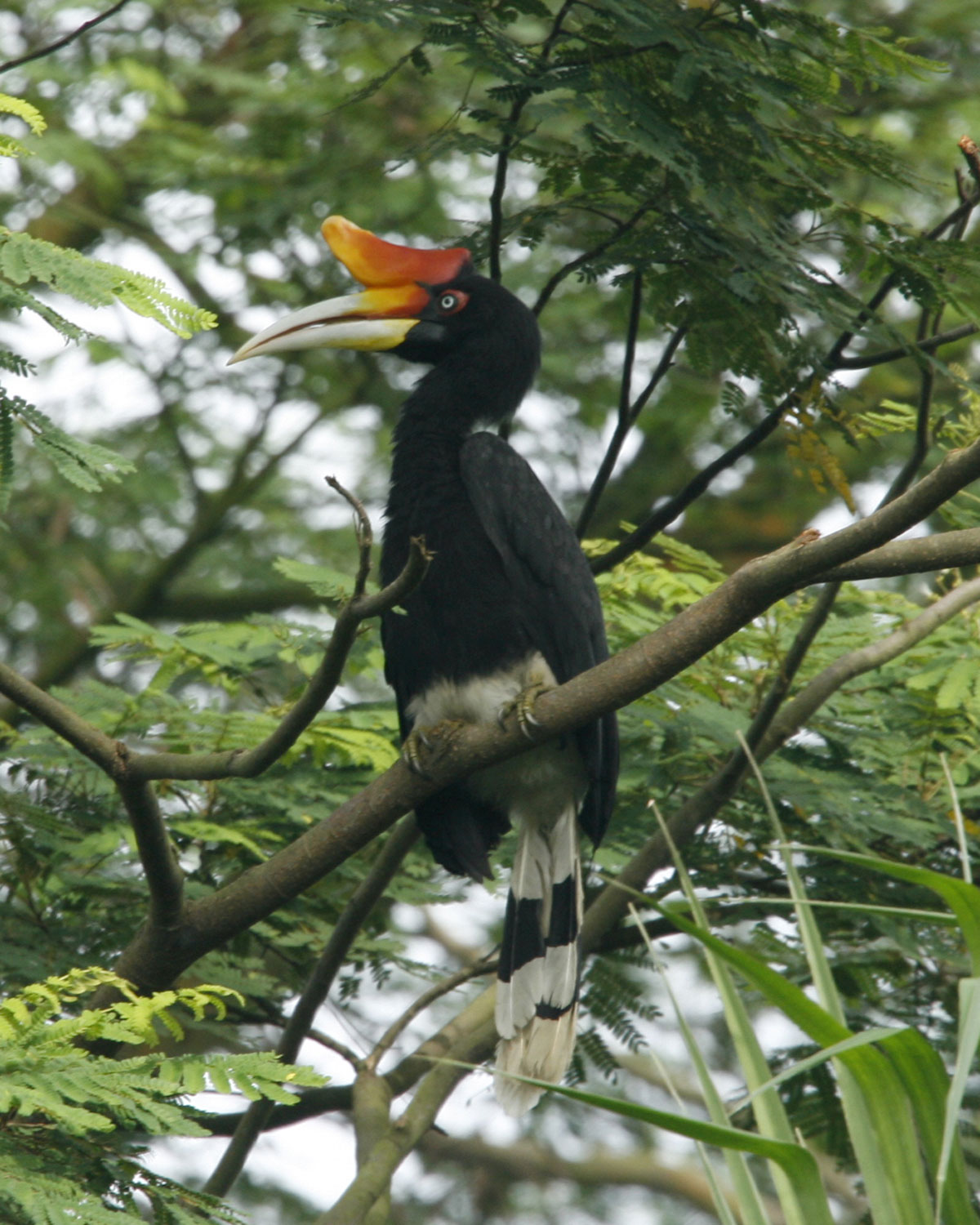 |
| White-bellied Sea Eagle {6} |
Rhinoceros Hornbill {7} |
Identifying An Albizia Tree:
- The Albizia tree can be commonly mistaken for the Rain Tree (Samanea saman) or Yellow Flame (Peltophorum pterocarpum) in SIngapore. This is because all three of them belongs to the same Family (Fabaceae), i.e. they are classified to be related species. The description(1) below allows one to easily spot an Albizia tree in their surrounding.
| This tree has rapid growth and capable of attaining a height of 30 meters. An open crown is located above the huge trunk. To compensate for the fast growth, the wood is soft and prone to break during storms. |
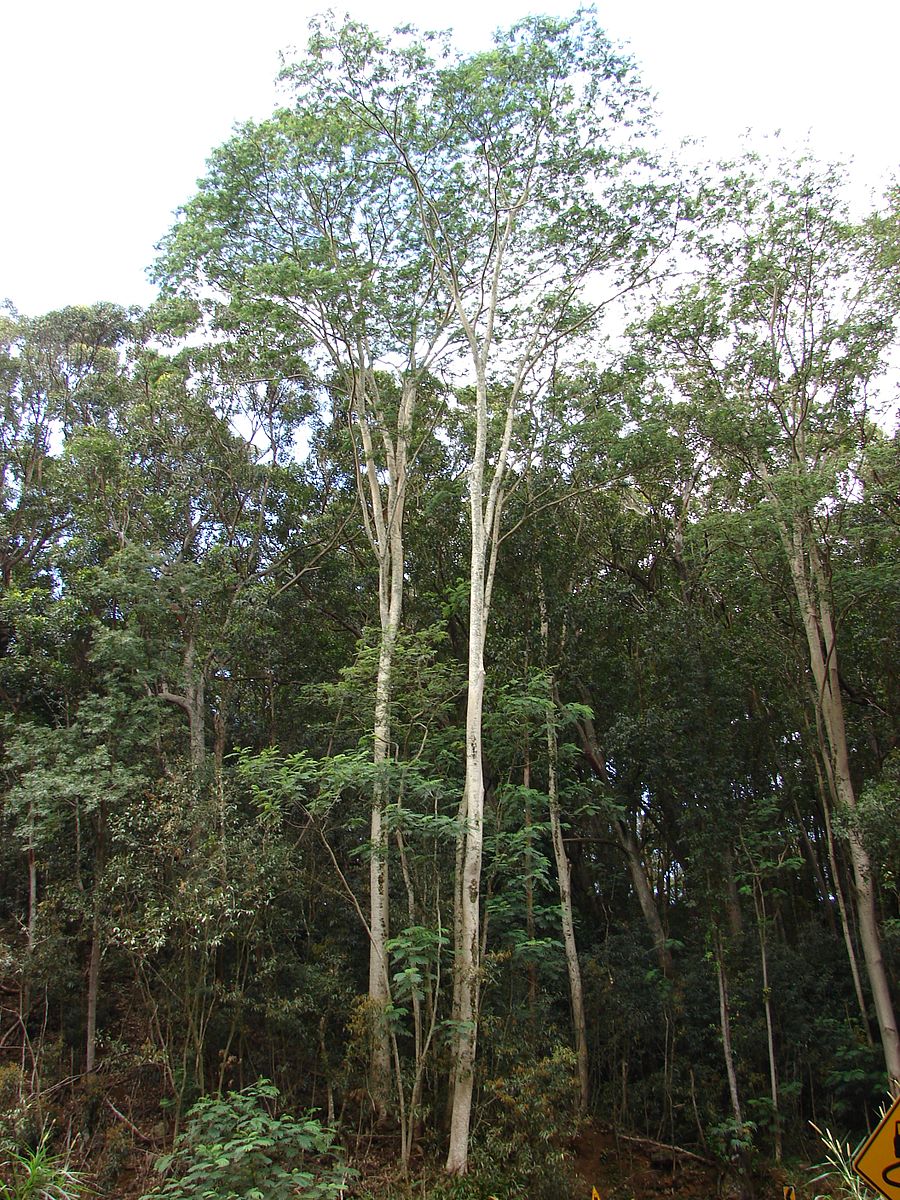 {8} |
| The compound leaf is bi-pinnate, approximately 15-30 cm long, with 8 to 12 or more pairs of primary leaflet and 15-25 pairs of secondary leaflet. The secondary leaflet is asymmetric, approximately 12 x 6 mm long and slightly curved with the midrib near the upper margin. |
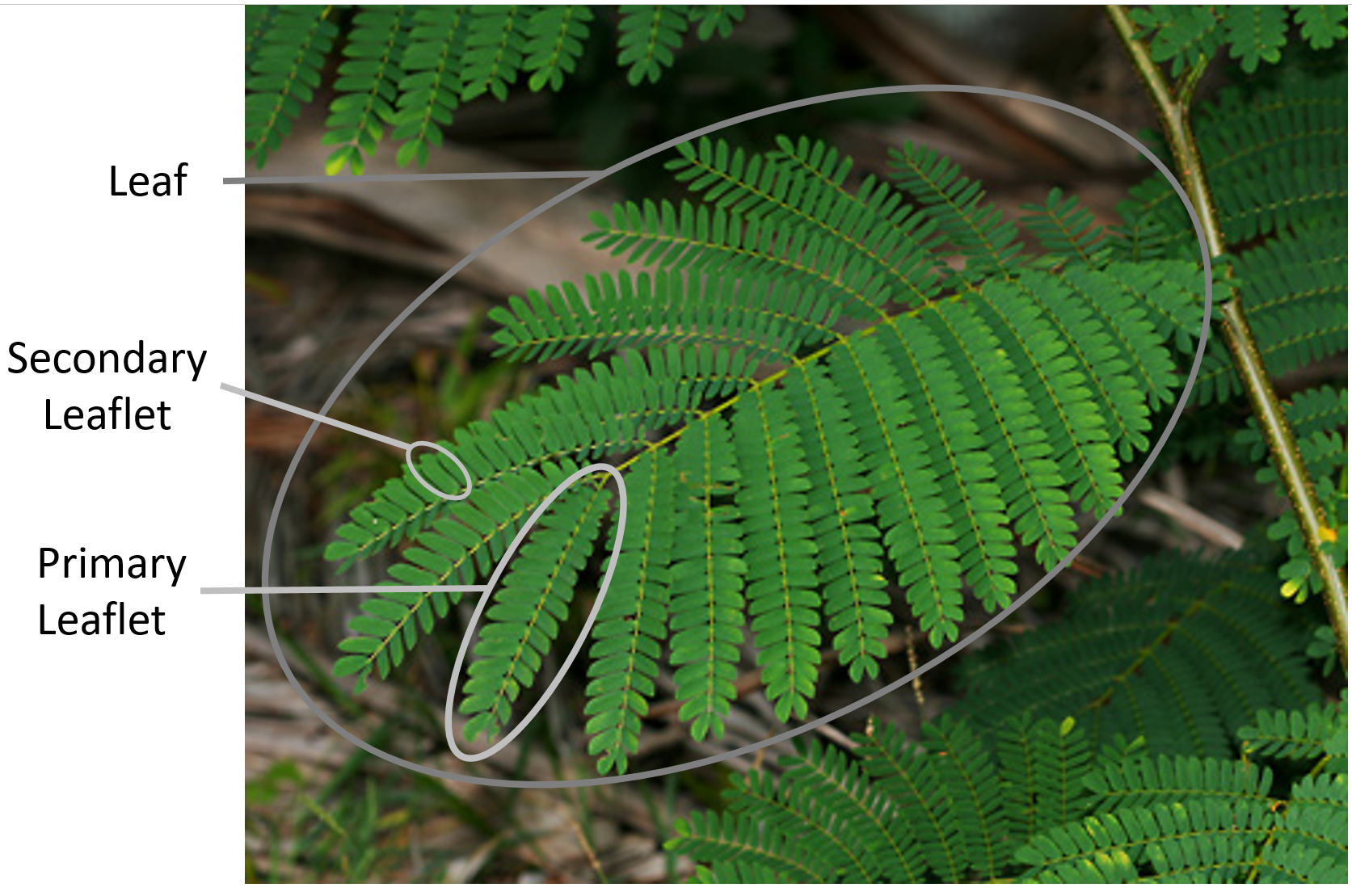 {9} |
| Flowers are attached singly within an inflorescence. Each flower is small and cream-white in colour; they are slightly fragrant too. Its fruits are thin woody pods measuring 10-14 cm long; upon splitting, each pod is observed to have numerous seeds. |
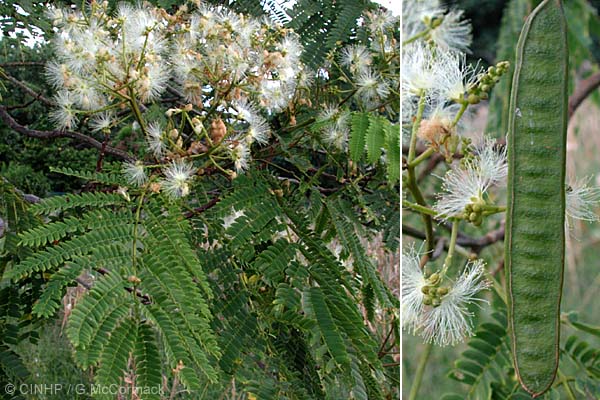 {10} |
- While the leaves and fruits looks similar, across the three plants, the smaller crown and thin, long trunk of Albizia, allows the general public to differentiate between the trees.
 |
 |
| Rain Tree (Samanea saman) {11} |
Yellow Flame (Peltophorum pterocarpum) {12} |
For more information on Albizia tree in Singapore, please visit the websites below:
- Invasive trees in Singapore: are they a threat to native forests?
- The Ecology Of Invasive Tree Species In Singapore
- Albizia Trees: "We Are Just Trees!"
- Wild news on wildsingapore
- Wild news on wildsingapore 2
- Risking falling trees for roti prata
- Storm-vulnerable Albizia trees to get the chop
- NParks' Tree Management Programme
- Nostalgia trees – Albizia
- Bird Ecology Study Group - Save our albizia trees
- Motor insurance covers damage caused by trees
Albizia Around The World:
- The following section explores Albizia beyond the Singapore context, where we look into biology and other issues that revolves around this plant. Albizia will be mentioned as "Falcataria moluccana" (F. moluccana), as other countries may not necessary adopt the same common name "Albizia".
Special Biological Characteristic Of F. moluccana:
- F. moluccana is capable of growing on nutrient deficient soil, as the symbiotic relationship with Rhizobia sp and endomychorrizal fungi, provides the plant with the nutrients required for growth. Soil bacteria such as Rhizobium spp can fix atmospheric nitrogen (2) providing the plant with ammonia in exchange for photosynthates by the plant host. These Rhizobium stay within the root nodules of the F. moluccana tree. Additionally, endomychorrizal fungi, which grow within the root cells of the F. moluccana tree, provides it with phosphorus(3). Phosphorus is another important nutrient necessary for growth.
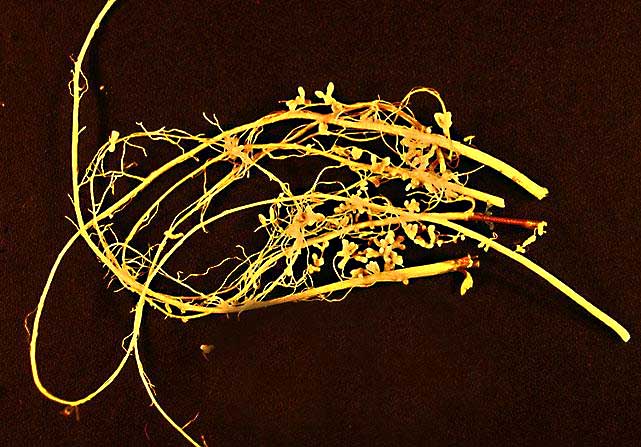 |
| Example of a soybean plant roots with root nodules containing Rhizobia soil bacteria that were established inside. {13} |
Distribution:
- The invasive properties(26) of F. moluccana, and its ability to spread and grow on various soil types, makes the precise tracking of F. moluccana distribution "not practicable". Hence bio-geographical range of F. moluccana are often illustrated using inaccurate political boundaries.
Countries which are known to be the native range for F. moluccana are:
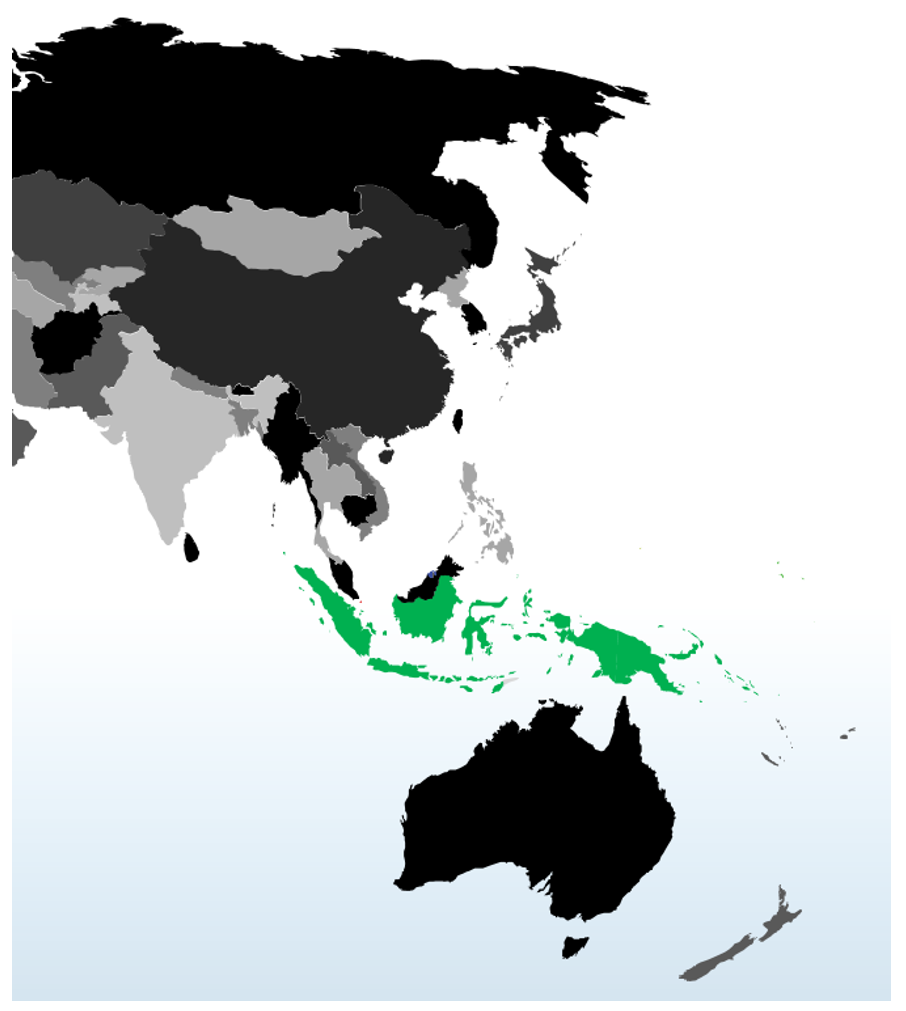 {14} |
Falcataria moluccana has also been know to be invasive in other areas, outside its native range, seen in the map below. For a more detailed view of the map, please visit the Centre for Agriculture and Bioscience International website. {15} |
Uses Of F. moluccana:
Companion Planting in Hawaii:
- As synthetic nitrogen fertilizers incur significant cost for plantations, the nitrogen fixation abilities of F. moluccana has been considered as an alternative method of enriching the soil nitrogen content. In Hawaii(5), Eucalpytus saligna plantation have utilized F. moluccana as a form of companion planting . It was observed that these Eucalpytus tree grew to bigger with the present of the companion F. moluccana tree, mixed within the plantation.
Tree Plantation for Wood (silviculture) in Indonesia:
- As F. moluccana is a fast-growing tree, its relatively soft wood(4) has many uses and sold cheaply in the international trade. These woods are processed into finger joint lumber, plywood, and block board. However, its softness prevents it from being used as structural construction materials, where preservatives have to be added to prevent attacks by beetles, termites, and fungi.
- Falcataria moluccana has been planted on deforested sites as part of industrial-planting and rehabilitation programmes(28). These plantations are managed by smallholder farmers (individual households) under the Hutan Rakyat (Farm Forestry). However it is debatable whether there has been cases of forest illegally cleared to expand plantation area. The pulpwood was noted to be ready for harvest within 6-8 years(29).
- More details on the silviculture of F. moluccana can be found in this article: Research on industrial forest plantation establishment with Paraserianthes falcataria (L.) Nielsen and Gmelina arborea Roxb for wood supply
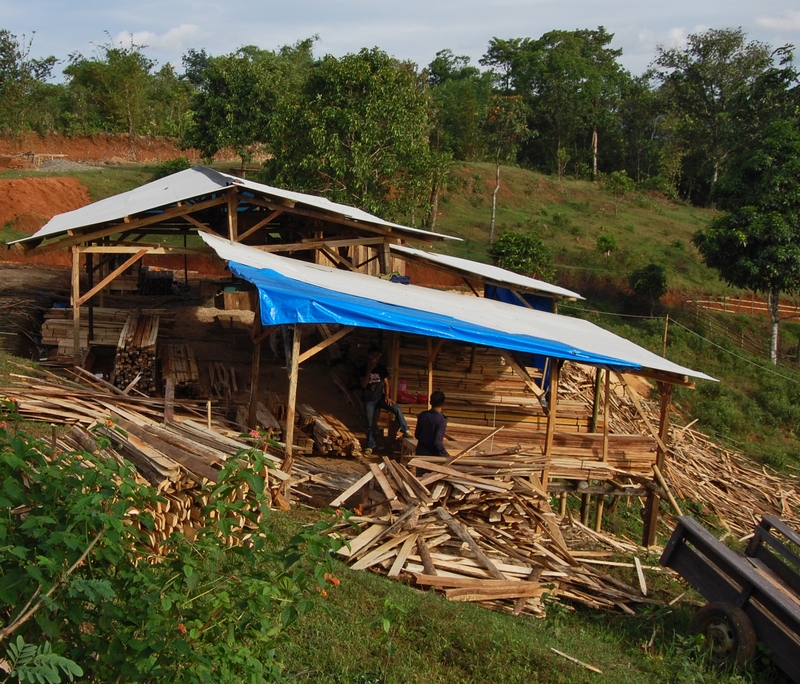 |
| Small sawmill processing F. moluccana timber. Bogor, West Java, Indonesia. {16} |
Invasive Nature Of F. moluccana:
- It was noted that F. moluccana was initially planted by humans outside its native range for landscaping or other purposes(7). This long distance dispersal by human has resulted in widespread invasion of F. moluccana. Naturally, F. moluccana is capable of producing large quantity of seeds, where the light weighted seed pods are dispersed great distances by the wind(8). It is known that a healthy F. moluccana (5-8 year-old) is capable of producing up to 12,000 viable seeds per hectare(9).
Case Study Of Invasion On American Samoa:
- Assisted by its symbiotic microbes, F. moluccana can grow on various soil type and even degraded soil(10,11,12,13) in just 3-6 years, Falcataria moluccana reaches reproductive maturity and the plant is capable of producing large quantity of seeds which remains viable for many months in the seed bank(14). On American Samoa, cyclone events are frequent and acts as a source of disturbance. This provided opportunities for the fast growing F. moluccana seedlings to capitalize on the forest gaps(15,16) changing the direction of secondary succession after disturbance. Its tall height and large umbrella shaped crown, resulted in large areas to be dominated by F. moluccana only(17), as other species are unable to compete for sufficient sunlight. Invasion of F. moluccana was threatening to the native forest, and virtually eliminate the Metrosideros polymorpha tree which was once the dominant native tree species. Furthermore, the invasion by non-native Psidium cattleianum tree, was assisted by the F. moluccana invasion.
Pest And Diseases Of F. moluccana:
Plant Disease Of F. moluccana:
- F.moluccana is also susceptible to plant diseases such as damping-off fungi (Pythium, Rhizoctonia, and Phytophthora spp.) and gall rust by Uromycladium tepperianum(19).
Insect Pest Of F. moluccana:
- In Indonesia, F. moluccana plantations, meant for the timber industry, suffer from insect pest(18,19) such as: the yellow butterfly (Eurema sp.), small bagworm (Pteroma plagiophleps), and stem borer (Xystrocera festiva). The small bagworm (Pteroma plagiophleps) has been noted to defoliate the F. moluccana trees usually, and capable of causing a patch of endemic, severe infection in Sumatra. Tree die back is observed when many bagworm larvae feed on the bark and leaves of F. moluccana, causing the tree to shed its skeletonised leaf.
- A potential host shift was also observed in the endemic Hawaiian moth caterpillar Koa Looper (Geometridae: Scotorythra paludicola). It was noted that these caterpillar fed on F. moluccana and also it host plant Acacia koa(21). Hence there is a possibility of utilizing the potential host shift by S. paludicola, as a form of biological control against F. moluccana invasion. However, further studies are necessary.
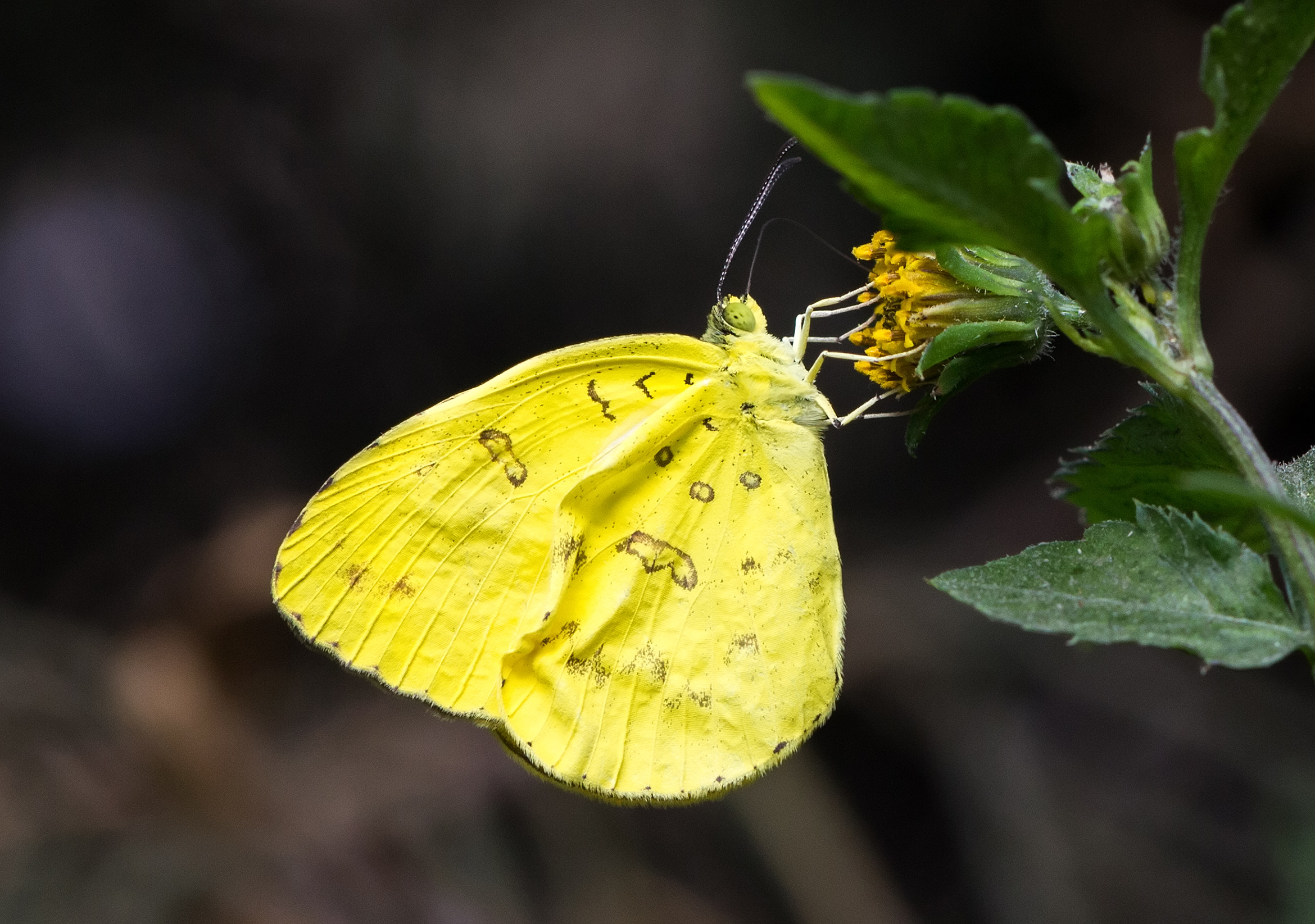 |
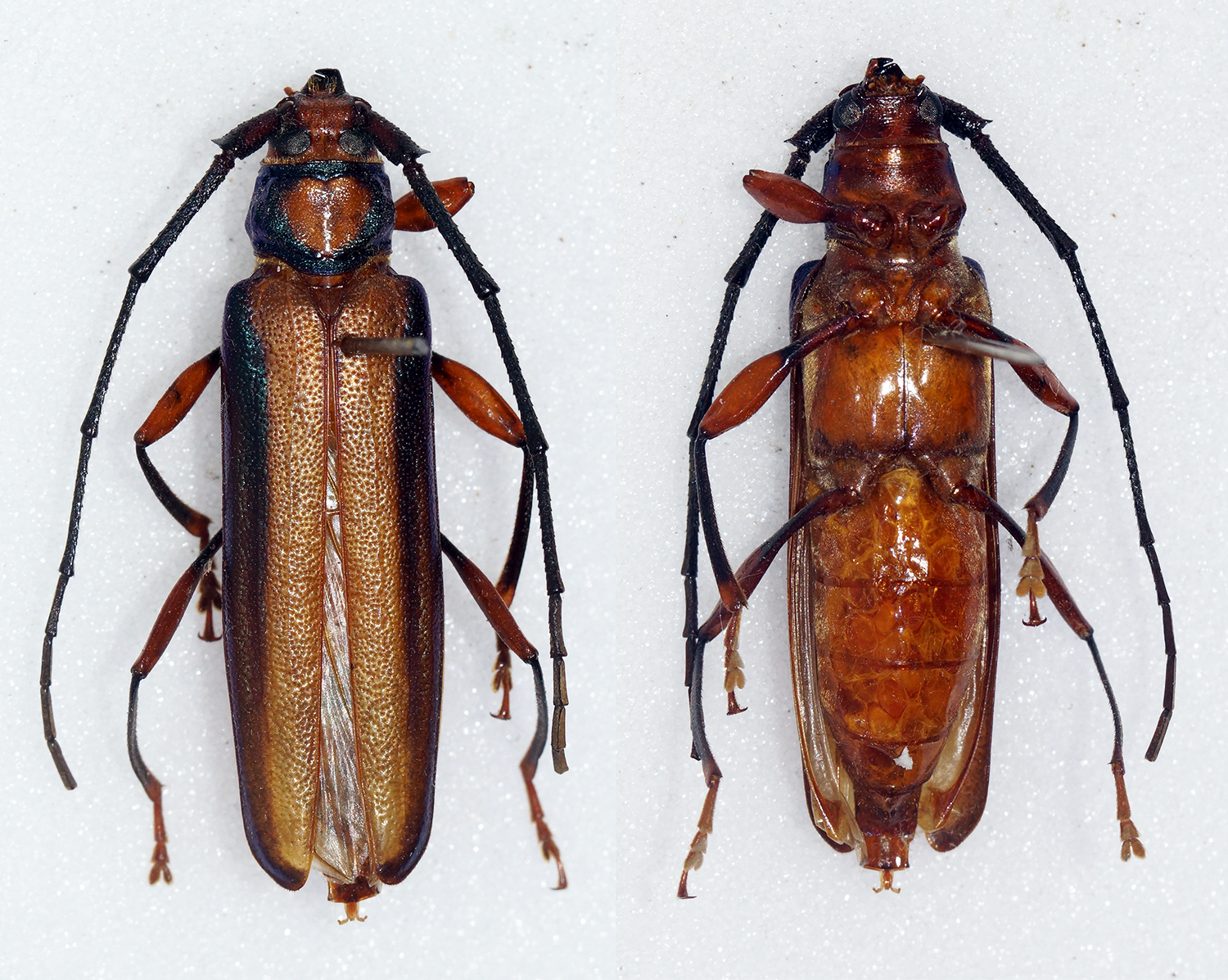 |
 |
| Eurema blanda, an example of the yellow butterfly (Eurema sp.) {17} |
Stem borer (Xystrocera festiva) {18} |
The Hawaiian moth caterpillar Koa Looper (Scotorythra paludicola) {19} |
Methods To Remove F. moluccana
Removal By Girdling:
- A study in American Samoa, noted that it takes nearing eight years to remove the invasive F. moluccana tree by girdling(20), from its native forest there. Girdling of the tree involves removing a strip of the living tissues around the circumference of the trunk (including phloem and xylem). This disrupts the circulation of water and nutrient within the tree, and eventually causing its death. Native plants were able to now grow on the enriched soil, in the absence of F. moluccana, which aided in the recovery of the native forest. However, with the removal of F. moluccana, the associate microbes were also removed, causing inorganic nitrogen and nitrate value in soil to decrease to the levels similar to the original native soil after three years. Similarly, the initial high density of of F. moluccana seedlings took three years to be totally eliminated from the native forest.
 |
| Example of girdling, also called ring barking, which completely remove a strip of bark around the tree to kill it. {20} |
Injection Methods For Controlling F. moluccana:
Taxonomy Information Of F. moluccana:
- The following section explores the taxonomic related work performed on the Albizia tree. Hence, Albizia will be mentioned by its scientific names of Falcataria moluccana and synonyms (e.g. Paraserianthes falcataria), for clearer illustration.
Detailed Description Of F. moluccana:
- The taxonomic description of F. moluccana which was described and published by Carl Linnaeus originally (under Adenanthera falcata L and other synonyms) were not often used as the botanical description for this plant. Among the various description for F. moluccana, the description by Wagner et al., 1999(22) is more commonly used, as shown below:
- "Trees up to 40 m tall, bark white, gray or greenish, smooth or slightly warty, young parts densely reddish brown tomentose or puberulent. Leaves with a large nectary below the lowermost pair of pinnae and smaller ones between or below most pairs of pinnae, pinnae (4-) 8-15 pairs, leaflets 15-25 pairs per pinna, obliquely elliptic, falcate, 10-20 mm long, 3-6 mm wide, midrib strongly excentric near 1 of the margins. Flowers in panicles ca 20 cm in diameter, often with 2 serial branches from 1 bract scar; calyx 1-1.5 mm long, silky pubescent, the teeth 0.5 mm long; corolla cream or greenish yellow, 3-4.5 mm long (excl. stamens); stamens 10-17 mm long. Pods 9-12 cm long, 1.5-2.5 cm wide, densely pubescent or glabrous, with a narrow, longitudinal wing along the upper suture. Seeds transversely arranged, ellipsoid, 5-7 mm long, 2.5-3.5 mm wide, laterally flattened, with a pleurogram ca 3 mm long and 1.5 mm wide\"
Etymology:
- The initial name of the plant was Paraserianthes falcataria (L.) I.C.Nielsen, and later renamed as Falcataria moluccana (Miq.) Barneby & J.W.Grimes; which had the following meaning(23):
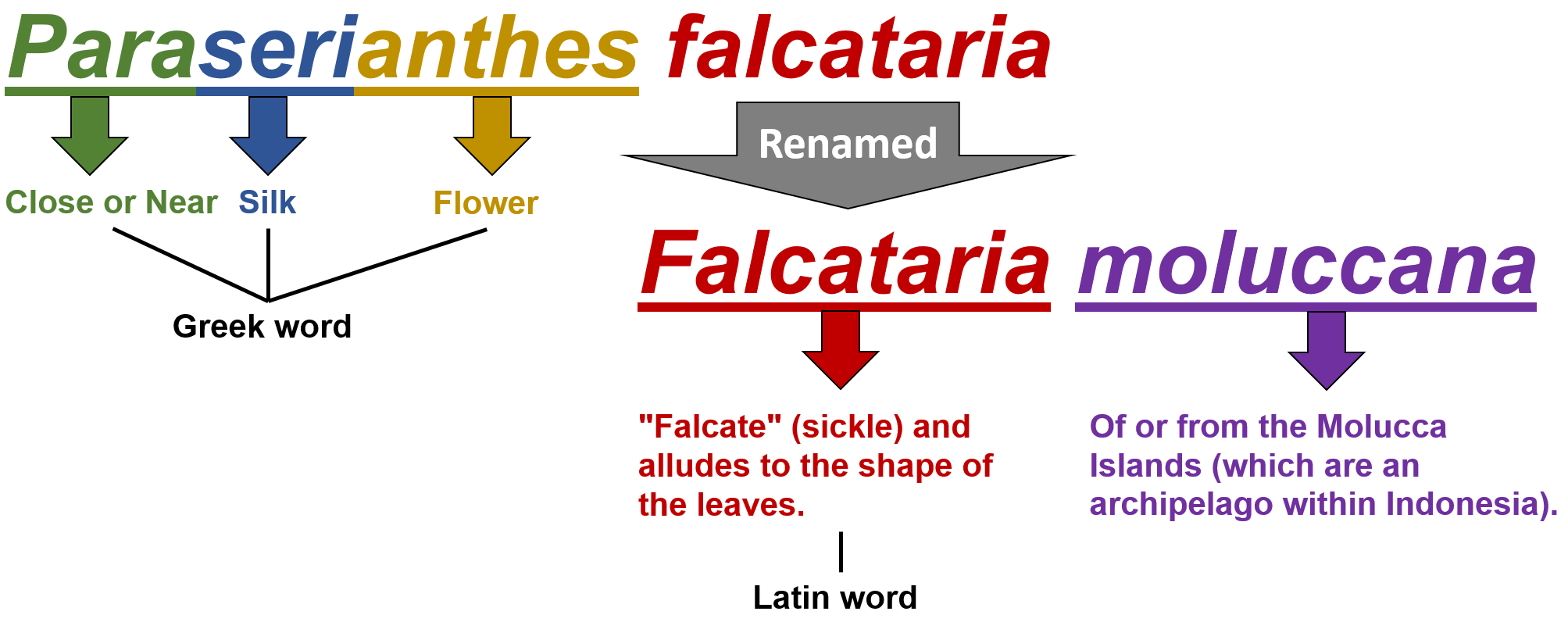 {21}
{21}Taxonomic Classification:
- Falcataria moluccana is commonly classified under the following manner:
| Kingdom: |
Plantae |
| Phylum/Division: |
Magnoliophyta |
| Class: |
Eudicots |
| Order: |
Fabales |
| Family: |
Fabaceae |
| Genus: |
Falcataria |
| Species: |
F. moluccana |
Synonym:
- Falcataria moluccana goes by several names(24) of:
| Adenanthera falcata L. |
species |
SYNONYM |
| Adenanthera falcataria L. |
species |
SYNONYM |
| Adenanthera falcatoria L. |
species |
SYNONYM |
| Albizia eymae Fosberg |
species |
HETEROTYPIC SYNONYM |
| Albizia falcata (L.) Backer |
species |
SYNONYM |
| Albizia falcata (L.) Backer ex Merr. |
species |
SYNONYM |
| Albizia falcataria (L.) Fosberg |
species |
SYNONYM |
| Albizia falcatoria (L.) Fosberg |
species |
SYNONYM |
| Albizia fulva C.T. White & Francis |
species |
SYNONYM |
| Albizia fulva Lane-Poole |
species |
SYNONYM |
| Albizia moluccana Miq. |
species |
SYNONYM |
| Paraserianthes falcataria (L.) I.C.Nielsen |
species |
SYNONYM |
| Paraserianthes falcataria subsp. falcataria |
subspecies |
SYNONYM |
| Paraserianthes falcataria subsp. fulva (Lane-Poole) I.C.Nielsen |
species |
SYNONYM |
| Paraserianthes falcatoria (L.) I.C.Nielsen |
subspecies |
SYNONYM |
Type Specimen:
- In taxonomy, a "type" refers to a particular specimen of an organism, which is attached to a scientific name. Hence scientist use this specimen to describe defining features of that particular organism. There are various forms of type specimens, among which, the holotype is considered the most valuable.
- The holotype of a species is the single specimen which is clearly designated in the original description. This holotype is usually kept in major museum and retrieved if there is a need for further examination.
- The isotype can be considered as a duplicate of the holotype, which can be another branch from the same individual plant.
Holotype And Isotype Of F. moluccana.
- From the Global Biodiversity Information Facility there were registrations for:
- the holotype for F. moluccana
- the isotype and holotype for sub-species of F. moluccana.
| HOLOTYPE L 0019190 Paraserianthes falcataria (L.) I.C.Nielsen Location: Pohon Siekat.Banda (Indonesia,Moluccas) Dataset (Storage): Naturalis Biodiversity Center (NL) - Botany For more information, click HERE |
| ISOTYPE K000654845 Paraserianthes falcataria subsp. fulva (Lane-Poole) I.C.Nielsen Location:Environs of Enarotalli; Wissel Lake region (Papua New Guinea) Dataset (Storage): Royal Botanic Gardens, Kew - Herbarium Specimens For more information, click HERE 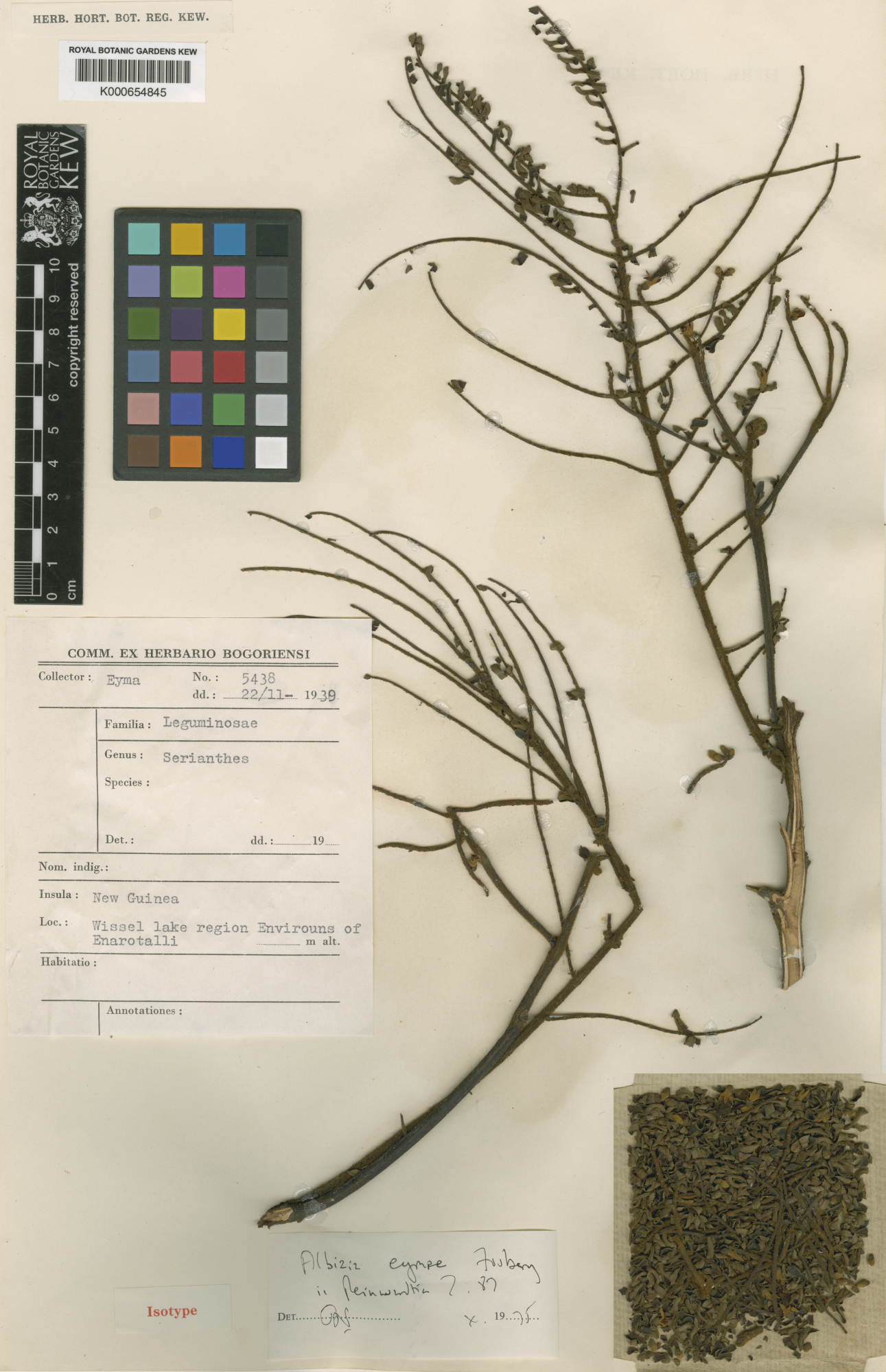 {22} |
HOLOTYPE barcode-00064319 Paraserianthes falcataria subsp. solomonensis I.C.Nielsen Location: Tiratona, mountain forests, 600 m (Isabel,Solomon Islands) Dataset (Storage): Harvard University Herbaria For more information, click HERE |
Renaming Of Paraserianthes falcataria:
Understanding Phylogenetic:
- Different species are known to share similar physical or genetic characteristic, and also posses certain distinct characteristics which allow scientist to differentiate between the different species. Using this characteristic, scientist are able to deduce the evolution or development of a particular group of organisms. This evolutionary history obtained, is the referred to as the phylogenetic relationships among a group of organisms which is mostly depicted as a family tree. This also allows scientist to the common ancestors of these organism. Studies of phylogenetic relationships often involves using DNA barcodes, which are short genetics markers with unique sequences for various species. This allows for the evolution tree to be drawn to allow scientist to deduce whether classification in the past have confused paraphyletic groups to be monophyletic.
Common Terms Used In Phylogenetics:
- Monophyletic: Refers to a group of organisms that consists of an ancestral species and all its descendants.
- Paraphyletic: Refers to a group of organisms that descended from a common evolutionary ancestor or ancestral group, but not including all the descendant groups.
- Monotypic: Having only one type or representative, especially (of a genus) containing only one species.
- Parsimony: The parsimony principle is basic to all science and tells us to choose the simplest scientific explanation that fits the evidence. In terms of tree-building, that means that, all other things being equal, the best hypothesis is the one that requires the fewest evolutionary changes.
- Bayesian: A type of probability theory. For more information, please visit Bayesian inference in phylogeny.
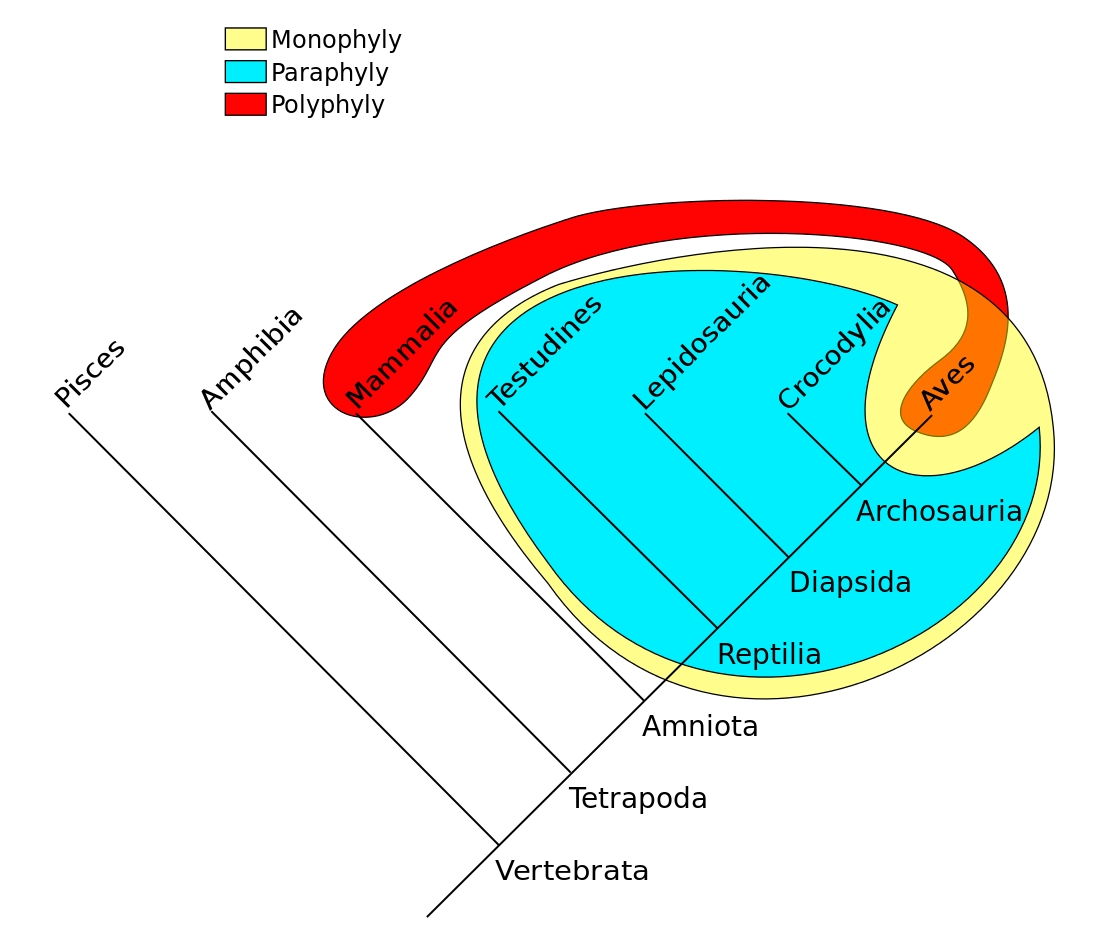 |
| Example of monophyletic, paraphyletic and polyphylectic group. {23} |
Phylogenetic Relationships of Paraserianthes:
- A phylogenetic study(25) involving Acacia sensu stricto (s.s.), which was suspected to be not monophyletic, has also suggested that the genus Paraserianthes was paraphyletic. The study used the external transcribed spacer regions of nuclear ribosomal DNA and the rpl32-trnL intergenic spacer of chloroplast DNA as the DNA barcode for analysis. Both parsimony and Bayesian methods were applied to draw out the phylogenetic tree, and it was noted that the topologies of phylogenetic trees by parsimony and Bayesian methods were congruent with greater resolution in the Bayesian tree.
- The conclusion was that the genus Paraserianthes, which was initially circumscribed by Nielsen et al., have four species and five subspecies present in Australia, Indonesia, New Guinea and the Solomon Islands; and the genus Paraserianthes was indeed paraphyletic. Hence, there was an effort to reclassify the genus Paraserianthes. Taxonomic work of Barneby and Grimes in 1996 have shifted P. falcataria out of the paraphyletic Paraserianthes, into the new genus Falcataria. There are also considerations to shift P. pullenii and P. toona to the genus Falcataria. This would result in Paraserianthes to become monotypic, having only P. lophantha. Greater sampling effort is necessary to determine how the subspecies described within P. falcataria should be classified. Furthermore, it was found that P. lophantha is the sister group to the genus Acacia (not monophyletic) and it is possible for Paraserianthes and Acacia to be of Australian origin, where the collision of the leading edge of Australia during Miocene times may have led to range expansion.
Reading Phylogenetic Tree:
- The main concern with phylogentic trees will be whether we can ascertain how strongly are the organism related to one another. In other words, whether the branches are supported or not statistically. Therefore, certain commonly used statistic calculations were the Posterior probability and Bootstrapping. The values can then be interpreted, so that one can decide for themselves how much evidence is present to support the relationship between organism. Both methods are known to have their statistical advantages and disadvantages.
- Generally, a value closer to "1" for posterior probability and a larger value closer to "100" for bootstrap, indicates that there is strong support or a higher chance that the organisms are related, base on the branching pattern of the phylogenetic tree. However, it is possible to have situations with a high posterior probability value and yet have a low bootstrap value. Such situation requires deeper investigation before charting out the tree.
- A good guide to understanding phylogenetic tree can be found on this website: How to read a phylogenetic tree
Possible Interpretation Of Phylogenetic Tree:
- The phylogenetic tree shown below is a zoomed in on the branches relevant to the discussion of F. moluccana. This phylogenetic tree from Baysesian analysis shows the nodes (“branches”) that are also found in the parsimony strict consensus tree. The posterior probabilities (PP) values are above the node, bootstrap values are below the node, and node numbers are in italics. Nodes 13, and 17 (asterisk) have bootstrap values of 54, and 55% respectively, which can be considered as low, weak support. However, node 17 is supported by the morphological character of black hard seeds, hence explaining for the higher value in PP.
- From the tree, the blue box has shown that P. lophantha came from a separate branch, as compared to P. falcataria (yellow star annotation in brown box) and its subspecies. Hence there was an argument present to shift P. falcataria out of the genus Paraserianthes, due to the strong support values on the nodes, which suggest that those species in the blue box are indeed on different evolutionary branches compared to those species in the brown box.
- However the weak support at node 13, indicates that more work is required before asserting that P. falcataria and P. toona can be grouped together under the new genus Falcataria. Furthermore, more analysis is required before including P. pullenii into genus Falcataria, as the strong support at node 12 suggest that P. pullenii may be less related to both P. falcataria and P. toona.
- Hence the only more conclusive evidence from this tree is that genus Paraserianthes can be deemed as paraphyletic. This would explain for the shifting of P. falcataria to a new genus of Falcataria.
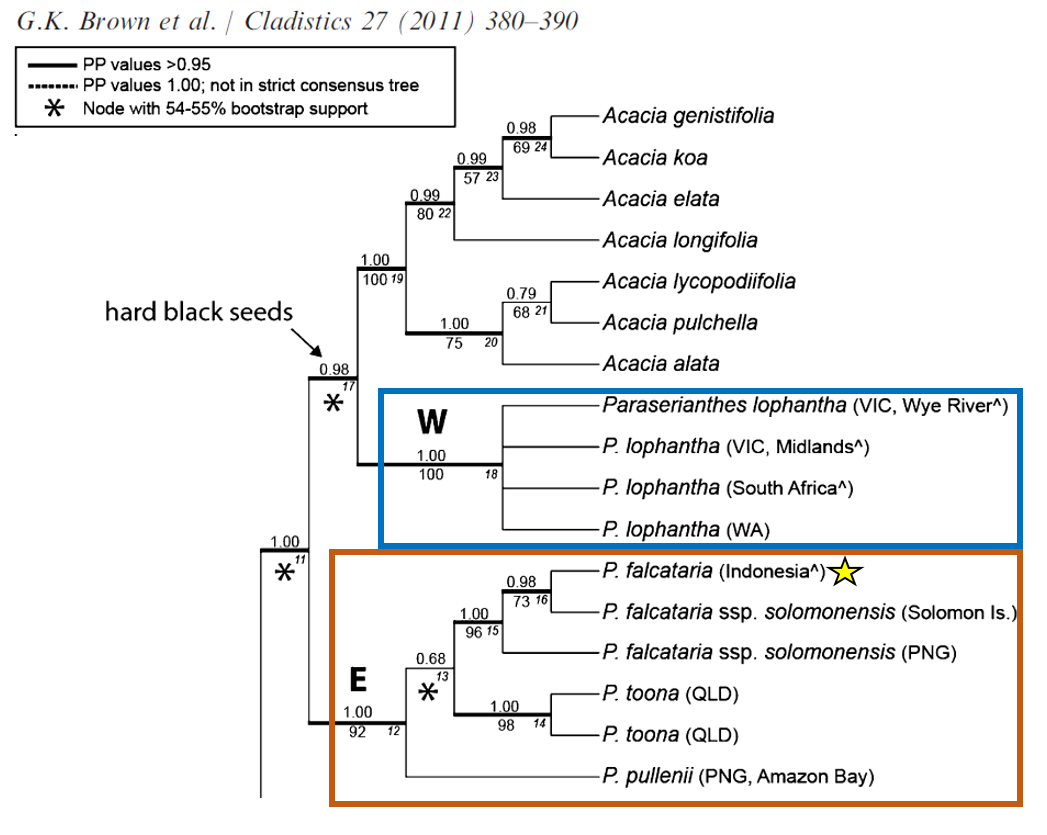 Relevant part of the phylogenetic tree (Bayesian analysis) is extracted from the original paper. More information regarding the methodology to obtain the phylogeny tree is found in the original research paper. {24} |
Renaming Of Paraserianthes falcataria:
- Although P. falcataria has been acknowledged to be shifted to the new genus Falcataria, the change in genus epithet, would result in a case of "tautonym", which is explicitly prohibited in the botanical nomenclature. In other words, the shift in genus for P. falcataria, would result in the new name to be "Falcataria falcataria", where this repeat of the same word for both the genus and species is not allowed in the field of botany. Therefore a new species epithet has to be created, resulting in a change in name to Falcataria moluccana.
- For more information regarding nomenclature in botany and detailed explanation of the change in name please visit the Wikipedia page: Correct name (botany)
Acknowledgement And References:
References:
(1) “Falcataria moluccana” by Lee Kong Chian Natural History Museum. URL: http://lkcnhm.nus.edu.sg/dna/organisms/hdetails/530/9 (accessed on 09 November 2016)(2) Allen O.N. and Allen E.K. 1981. The Leguminosae: A sourcebook of Characteristics,Uses and Nodulation. University of Wisconsin Press. Madison, Wisconsin,USA. p. 806.
(3) Garcia, M.U. 1989. Paraserianthes falcataria – Southeast Asia’s Growth Champion.In: NFT Highlights. NFTA 89-05. Nitrogen Fixing Tree Association, Waimanalo,Hawaii. p. 2.
(4) Nemoto, A. 2002. Farm tree planting and the wood industry in Indonesia: a study of Falcataria plantations and the Falcataria product market in Java. Policy Trend Report 2002: 42-51.
(5) DeBell, D. S., Whitesell, C. D., & Schubert, T. H. (1989). Using N2-fixing Albizia to increase growth of Eucalyptus plantations in Hawaii. Forest Science, 35(1), 64-75.
(6) "Storm-vulnerable Albizia trees to get the chop" by Walter Sim, The Straits Times (13 July 2013). URL: http://www.straitstimes.com/singapore/storm-vulnerable-albizia-trees-to-get-the-chop (accessed on 09 November 2016)
(7) Smith, C.W. 1998. Pest Plants of Hawaiian Native Ecosystems. [Online information] Hawaiian Alien Plant Studies, University of Hawai'i, Manoa, Botany Department and the National Park Service Cooperative Park Studies Unit. Available: http://www.botany.hawaii.edu/faculty/cw_smith/par_fal.htm
(8) Little, E.L. and R.G. Skolmen. 1989. Common Forest Trees of Hawai'i. Agriculture Handbook No. 679. United States Department of Agriculture, Washington, DC.
(9) Soerieanegara, I. and Lemmens, R. H. M. J. 1993. (ed.) Plant Resources of South-East Asia. No. 5(1) Timber trees: major commercial timbers. Pudoc Scientific Publishers, Wageningen, Netherlands.
(10) Otsamo A (1997) Evaluation of reforestation potential of 83 treespecies planted on Imperata cylindrica dominated grassland.New For 14:127–143
(11) Otsamo A (2002) Early effects of four fast-growing tree speciesand their planting density on ground vegetation in Imperatagrasslands. New For 23:1–17
(12) Debell DS, Whitesell CD, Schubert TH (1989) Using N2-fixingAlbizia to increase growth of Eucalyptus plantations inHawaii. For Sci 35:64–75
(13) Panjaitan M, Stur WW, Jessop R (1993) Growth of forage treelegumes at 4 agroclimatic sites in Indonesia. J Agric Sci120:311–317
(14) Parrotta JA (1990) Paraserianthes falcataria (L.) Nielsen. Batai, Moluccan sau. SO- ITF-SM-31. US Department ofAgriculture, Forest Service, Southern Forest ExperimentStation, New Orleans
(15) Denslow JS (1987) Tropical rainforest gaps and tree species diversity. Ann Rev Ecol Syst 18:431–451
(16) Hubbell SP, Foster RB (1987) Large-scale spatial structure of a neotropical forest. Rev Biol Trop 35:7–22
(17) Hughes RF, Denslow JS (2005) Invasion by a N2-fixing tree alters function and structure in wet lowland forests of Hawaii. Ecol Appl 15:1615–1628
(18) Nair, K.S.S. and Sumardi. 2000. Insect pests and diseases of major plantation species. In: Nair, K.S.S. (Ed.) Insect pests and diseases in Indonesian forests: an assessment of the major threats, research efforts and literature. Center for International Forestry Research, Bogor, Indonesia. p. 15 – 38.
(19) Rahayu, S., Lee, S.S. and Shukor, N.A.A. 2010. Uromycladium tepperianum, the gall rust fungus from Falcataria moluccana in Malaysia and Indonesia. Mycoscience 51:149–153.
(20) Hughes, R. F., Uowolo, A. L., & Togia, T. P. (2012). Recovery of native forest after removal of an invasive tree, Falcataria moluccana, in American Samoa. Biological Invasions, 14(7), 1393-1413.
(21) Haines, W. P., Barton, K. E., & Conant, P. (2013). Defoliation of the invasive tree Falcataria moluccana on Hawaii Island by the native koa looper moth (Geometridae: Scotorythra paludicola), and evaluation of five fabaceous trees as larval hostplants.
(22) Wagner, W.L., D.R. Herbst, and S.H. Sohmer. 1999. Manual of the Flowering Plants of Hawai'i. 2 vols. Bishop Museum Special Publication 83, University of Hawai'i and Bishop Museum Press, Honolulu, HI.
(23) “Garden Dictionary Word” by Backyard Gardener. URL: http://www.backyardgardener.com/gardendictionary/Falcaria.html (accessed on 09 November 2016)
(24) "Synonyms for "Falcataria moluccana" by The Global Biodiversity Information Facility URL: http://www.gbif.org/species/2968262/synonyms (accessed on 09 November 2016)
(25) Brown, G. K., Murphy, D. J., & Ladiges, P. Y. (2011). Relationships of the Australo‐Malesian genus Paraserianthes (Mimosoideae: Leguminosae) identifies the sister group of Acacia sensu stricto and two biogeographical tracks. Cladistics, 27(4), 380-390. URL: http://onlinelibrary.wiley.com/doi/10.1111/j.1096-0031.2011.00349.x/full (accessed on 09 November 2016)
(26) Global Invasive Species Database. (n.d.). Falcataria moluccana. Retrieved November 21, 2016, from http://www.iucngisd.org/gisd/species.php?sc=1249 (accessed on 20 November 2016)
(27) Wright, S. J., Kitajima, K., Kraft, N. J., Reich, P. B., Wright, I. J., Bunker, D. E., ... & Engelbrecht, B. M. (2010). Functional traits and the growth–mortality trade‐off in tropical trees. Ecology, 91(12), 3664-3674.
(28) Varis, E. (2011). Stand growth and management scenarios for Paraserianthes falcataria smallholder plantations in Indonesia (Doctoral dissertation, Helsingfors universitet).
(29) NFTA (1989, September). Paraserianthes falcataria - Southeast Asia's Growth Champion. Retrieved November 21, 2016, from http://factnet.winrock.org/fnrm/factnet/factpub/FACTSH/P_falcataria_bckup.html
Image Source:
| Image |
Licence Status |
| {1} "Falcataria moluccana" by Forest & Kim Starr. Starrenvironmental. URL: http://www.starrenvironmental.com/resources/ (accessed on 09 November 2016) |
CC BY 4.0 |
| {2} "Sonic Tomograph" by Kai Luck. URL:https://commons.wikimedia.org/wiki/File:PiCUS_Sonic_Tomograph_-_Schalltomograph.jpg (accessed on 19 November 2016) |
CC BY-SA 4.0 |
| {3} "Resistograph" by Frank Rinn URL: https://commons.wikimedia.org/wiki/File:Resistograph_(Foto).jpg (accessed on 19 November 2016) |
CC BY-SA 3.0 DE |
| {4} "Common Flameback" by Lip Kee Yap. URL: https://commons.wikimedia.org/wiki/File:Common_Flameback_(Dinopium_javanense_javanense)_-_Flickr_-_Lip_Kee.jpg (accessed on 19 November 2016) |
CC BY-SA 2.0 |
| {5} "Long-tailed Parakeet" by Lip Kee Yap. URL: https://commons.wikimedia.org/wiki/File:Psittacula_longicauda_-Queenstown_-Singapore-6.jpg (accessed on 19 November 2016) |
CC BY-SA 2.0 |
| {6} "White-bellied Sea Eagle" by Lip Kee Yap. URL: https://commons.wikimedia.org/wiki/File:White-bellied_Sea-Eagle_(Haliaeetus_leucogaster).jpg (accessed on 19 November 2016) |
CC BY-SA 2.0 |
| {7} "Rhinoceros Hornbill" by Lip Kee Yap. URL: https://commons.wikimedia.org/wiki/File:Buceros_rhinoceros_(female)_-Singapore-6.jpg (accessed on 19 November 2016) |
CC BY-SA 2.0 |
| {8} "Falcataria moluccana" by Forest & Kim Starr. Starrenvironmental. URL: http://www.starrenvironmental.com/resources/ (accessed on 09 November 2016) |
CC BY 4.0 |
| {9} "Falcataria moluccana – Moluccan Albizia" by T. Beth Kinsey, (2016). URL: http://wildlifeofhawaii.com/flowers/1415/falcataria-moluccana-moluccan-albizia/ (accessed on 09 November 2016) Annotated by Seng Chin Teck. |
(Permission pending) |
| {10} "Albizia" by The Cook Islands Natural Heritage Trust. URL: http://cookislands.bishopmuseum.org/species.asp?id=6477 (accessed on 09 November 2016) |
Permitted |
| {11} "Rain_tree_by_the_roadside" by Mokkie. URL: https://commons.wikimedia.org/wiki/File:Rain_tree_by_the_roadside.jpg (accessed on 09 November 2016) |
CC BY-SA 3.0 |
| {12} "Yellow_flame_tree" by Mokkie. URL: https://commons.wikimedia.org/wiki/File:Yellow_flame_tree.jpg (accessed on 09 November 2016) |
CC BY-SA 3.0 |
| {13} "Root nodules, containing billions of rhizobia" by Wikimedia Commons. URL: https://commons.wikimedia.org/wiki/File:Soybean-root-nodules.jpg (accessed on 09 November 2016) |
Public Domain |
| {14} Image created by Seng Chin Teck using World Map PowerPoint Slides. URL: http://www.m62.net/powerpoint-slides/logistics-presentations/world-map-powerpoint-slides/ |
Image created by Seng Chin Teck |
| {15} "Distribution Maps" by Centre for Agriculture and Bioscience International. URL: http://www.cabi.org/isc/datasheet/38847 (accessed on 19 November 2016) |
CC BY-NC-SA 3.0 |
| {16} "Small sawmill processing Paraserianthes falcataria timber" by Wibowo Djatmiko. URL: https://commons.wikimedia.org/wiki/File:Parase_falcata_071230-3092_jsga.jpg (accessed on 09 November 2016) |
CC BY-SA 3.0 |
| {17) "Eurema blanda" by Crisco 1492. URL: https://commons.wikimedia.org/wiki/File:Eurema_blanda,_Bandungan,_Semarang_Regency,_2014-09-03_02.jpg (accessed on 09 November 2016) |
CC BY-SA 4.0 |
| {18} "Xystrocera festiva" by Ben Sale. URL: https://commons.wikimedia.org/wiki/File:Xystrocera_festiva_-_Flickr_-_Bennyboymothman.jpg (accessed on 09 November 2016) |
CC BY 2.0 |
| {19} "Scotorythra paludicola"by Forest & Kim Starr. Starrenvironmental URL: https://commons.wikimedia.org/wiki/File:Scotorythra_paludicola_(Koa_Moth)_(8484263192).jpg (accessed on 09 November 2016) |
CC BY 2.0 |
| {20} "Girdling" by Lamiot. URL: https://commons.wikimedia.org/wiki/File:AnnelageAnn%C3%A9lationGirdling1LilleLamiot3Detail.jpg (accessed on 09 November 2016) |
CC BY 3.0 |
| {21} Etymology. Image created by Seng Chin Teck. |
Image created by Seng Chin Teck |
| {22} "ISOTYPE K000654845" by The Board of Trustees of the Royal Botanic Gardens, Kew. URL: http://www.gbif.org/occurrence/912516450 (accessed on 09 November 2016) |
CC BY 4.0 |
| {23} "Phylogenetic groups" by TotoBaggins. URL: https://en.wikipedia.org/wiki/File:Phylogenetic-Groups.svg (accessed on 19 November 2016) |
Public Domain |
| {24} Relevant part of the phylogenetic tree (Bayesian analysis) is extracted from the original paper “Relationships of the Australo‐Malesian genus Paraserianthes (Mimosoideae: Leguminosae) identifies the sister group of Acacia sensu stricto and two biogeographical tracks”. Annotated by Seng Chin Teck. |
Fair Use |
External Links:
- Afforestation: https://en.wikipedia.org/wiki/Afforestation
- Albizia Trees: "We Are Just Trees!": http://www.natureloveyou.sg/Plant%20Story/Plant%20Story%20-%20Albizia%20Trees.html
- Bayesian inference in phylogeny: https://en.wikipedia.org/wiki/Bayesian_inference_in_phylogeny
- BESG, Bird Ecology Study Group: http://www.besgroup.org/
- Bi-pinnate: https://en.wikipedia.org/wiki/Pinnation
- Bird Ecology Study Group - Save our albizia trees: http://www.besgroup.org/2008/01/29/save-our-albizia-trees/
- Bootstrapping (statistics): https://en.wikipedia.org/wiki/Bootstrapping_(statistics)
- Bukit Batok Nature Park: https://www.nparks.gov.sg/gardens-parks-and-nature/parks-and-nature-reserves/bukit-batok-nature-park
- Carl Linnaeus: https://en.wikipedia.org/wiki/Carl_Linnaeus
- Centre for Agriculture and Bioscience International: http://www.cabi.org/isc/datasheet/38847
- Companion planting: https://en.wikipedia.org/wiki/Companion_planting
- Correct name (botany): https://en.wikipedia.org/wiki/Correct_name_(botany)
- Crown (botany): https://en.wikipedia.org/wiki/Crown_(botany)
- CUGE: https://www.cuge.com.sg/
- Damping off: https://en.wikipedia.org/wiki/Damping_off
- Disturbance: https://en.wikipedia.org/wiki/Disturbance_(ecology)
- Endomychorrizal fungi: https://microbewiki.kenyon.edu/index.php/Endomycorrhizal_fungi
- Eudicot: https://en.wikipedia.org/wiki/Eudicots
- Gall: https://en.wikipedia.org/wiki/Gall
- Girdling: https://en.wikipedia.org/wiki/Girdling
- Global Biodiversity Information Facility: http://www.gbif.org/
- Global Invasive Species Database: http://www.iucngisd.org/gisd/species.php?sc=1249
- Harvard University Herbaria: http://demo.gbif.org/dataset/861e6afe-f762-11e1-a439-00145eb45e9a
- Heterotypic synonym: http://wikidiff.com/heterotypic/synonymy
- HOLOTYPE barcode-00064319: http://demo.gbif.org/occurrence/727319049
- HOLOTYPE L 0019190: http://www.gbif.org/occurrence/1139486567
- How to read a phylogenetic tree: http://epidemic.bio.ed.ac.uk/how_to_read_a_phylogeny
- Inflorescence: http://www.visualdictionaryonline.com/plants-gardening/plants/flower/types-inflorescences.php
- Injection Methods for Controlling F.moluccana: https://www.youtube.com/watch?v=HDbzSVwH5-A
- Invasive trees in Singapore: are they a threat to native forests?: http://tropicalconservationscience.mongabay.com/content/v8/tcs_v8i1_201-214_Nghiem.pdf
- Invasive: https://en.wikipedia.org/wiki/Invasive_species
- ISOTYPE K000654845: http://www.gbif.org/occurrence/912516450
- Jelutong: http://taxo4254.wikispaces.com/Dyera+costulata
- Monophyletic: https://en.wikipedia.org/wiki/Monophyly
- Motor insurance covers damage caused by trees: http://www.straitstimes.com/singapore/motor-insurance-covers-damage-caused-by-trees
- Naturalis Biodiversity Center (NL) - Botany: http://www.gbif.org/dataset/15f819bd-6612-4447-854b-14d12ee1022d
- Nostalgia trees – Albizia: http://goodmorningyesterday.blogspot.sg/2013/07/nostalgia-trees-albizia.html
- NParks' Tree Management Programme: https://www.nparks.gov.sg/news/2013/1/nparks-tree-management-programme
- Paraphyletic: https://en.wikipedia.org/wiki/Paraphyly
- Phylogenetic: https://en.wikipedia.org/wiki/Phylogenetic_tree
- Posterior probability: https://en.wikipedia.org/wiki/Posterior_probability
- Rain Tree: https://www.nparks.gov.sg/activities/family-time-with-nature/recommended-activities/know-10-trees/1-rain-tree
- Research on industrial forest plantation establishment with Paraserianthes falcataria (L.) Nielsen and Gmelina arborea Roxb for wood supply: http://www.mekonginfo.org/assets/midocs/0003076-environment-research-on-industrial-forest-plantation-establishment-with-paraserianthes-falcataria-l-nielsen-and-gmelina-arborea-roxb-for-wood-supply.pdf
- Resistograph: http://www.rinntech.de/content/view/8/34/lang,english/
- Rhizobia sp: https://en.wikipedia.org/wiki/Rhizobia
- Risking falling trees for roti prata: http://www.straitstimes.com/singapore/risking-falling-trees-for-roti-prata
- Royal Botanic Gardens, Kew - Herbarium Specimens: http://www.gbif.org/dataset/cd6e21c8-9e8a-493a-8a76-fbf7862069e5
- Secondary succession: https://en.wikipedia.org/wiki/Secondary_succession
- Storm-vulnerable Albizia trees to get the chop: http://www.straitstimes.com/singapore/storm-vulnerable-albizia-trees-to-get-the-chop
- Tautonym: https://en.wikipedia.org/wiki/Tautonym
- Tembusu: http://taxo4254.wikispaces.com/Fagraea+fragrans
- The Albizia Problem: http://www.nature.org/ourinitiatives/regions/northamerica/unitedstates/hawaii/explore/the-albizia-problem.xml
- The Ecology Of Invasive Tree Species In Singapore: http://scholarbank.nus.edu.sg/bitstream/handle/10635/22119/NghiemTPL.pdf?sequence=1
- Tomograph: https://en.wikipedia.org/wiki/Tomography
- Tradeoff: http://www.evolutionnews.org/2014/01/comparing_expla081681.html
- White-bellied Sea Eagle: http://taxo4254.wikispaces.com/White-bellied+Sea+Eagle
- Wild news on wildsingapore: http://www.wildsingapore.com/news/20070506/070515-5.htm#st
- Wild news on wildsingapore 2: http://www.wildsingapore.com/news/20070506/070518-1.htm
- Yellow butterfly (Eurema sp.): https://en.wikipedia.org/wiki/Eurema
- Yellow Flame: https://www.nparks.gov.sg/activities/family-time-with-nature/recommended-activities/know-10-trees/3-yellow-flame